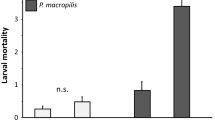Summary
Selection of sites for oviposition when the risk of predation by green frogs was variable studied in tandems of the damselfly Pyrrhosoma nymphula. In the absence of predators the number of tandems landing increased with the size of the oviposition site and with the number of pairs already present. Pairs approaching an oviposition site landed promptly and preferred locations near other ovipositing pairs. Pairs which had landed near others left the landing site and flew to another water plant after a shorter period than those landing alone. They stayed in groups for only 16.5% of the total duration of stay at the oviposition site. With predators present fewer tandems landed. There was no relationship between the landing site of solitary tandems and the locations of the perching frogs. Pairs landing in groups were disturbed by frogs after a shorter period than pairs landing alone. Damselfly aggregation did not affect the predation success of the frogs, but the predation risk to individual tandem pairs was reduced.
Similar content being viewed by others
References
Bertram BC (1978) Living in groups: predators and prey. In: Krebs JR, Davis NB (eds) Behavioural ecology: an evolutionary approach. Blackwell, Oxford, pp 64–96
Bick GH, Bick JC (1965) Demography and behaviour of the damselfly, Argia apicalis (Say) (Odonata: Coenagriidae). Ecology 46:461–472
Cooper SD (1984) The effects of trout on water striders in stream pools. Oecologia 63:376–379
Corber PS (1952) An adult population study of Pyrrhosoma nymphula (Sulzer): (Odonata: Coenagrionidae). J Anim Ecol 21:206–222
Corbet PS (1962) A biology of dragonflies. Witherby, London
Curio E (1976) The ethology of predation. In: Zoophysiology and ecology, vol 7. Springer, Berlin Heidelberg New York
Edmunds M (1974) Defense in animals. Longman Inc, New York
Fincke OM (1988) Sources of variation in lifetime reproductive success in a nonterritorial damselfly (Odonata: Coenagrionidae). In: Clutton-Brock TH (ed) Reproductive success: studies of individual variation in contrasting breeding systems. University of Chicago Press, Chicago London, pp 24–43
Foster WA, Treherne JE (1981) Evidence for the dilution effect in the selfish herd from fish predation on a marine insect. Nature 293:466–467
Hafernik JE, Garrison RW (1986) Mating success and survivorship in a population of damselflies: Results at variance with theory? Am Nat 128:353–365
Hamilton WD (1971) Geometry for the selfish herd. J Theor Biol 31:295–311
Hassell MP, May RM (1974) Aggregation of predators and insect parasites and its effect on stability. J Anim Ecology 43:567–594
Jacobs ME (1995) Studies on territorialism and sexual selection in dragonflies. Ecology 36:566–586
Kerfoot WC, Sih A (eds) (1987) Predation: direct and indirect impacts on aquatic communities. University Press of New England, Hanover, New Hampshire
Loibl E (1958) Zur Ethologie und Biologie der deutschen Lestiden (Odonata). Z Tierpsych 15:54–81
Lazarus J (1979) The early warning function of flocking in birds: an experimental study with captive quelea. Anim Behav 26:760–777
Martens A (1989) Aggregation of tandems in Coenagrion pulchellum (Van der Linden, 1825) during oviposition (Odonata: Coenagrionidae). Zool Anz 223:124–128
Martens A, Rehfeldt G (1989) Female aggregation in Platycypha caligata (Odonata: Chlorocyphidae): a tactic to evade male interference during oviposition. Anim Behav 38:369–374
Morse DH (1980) Behavioural Mechanism in Ecology. Harvard University Press, Cambridge
Peckarsky BL (1982) Aquatic insect predator — prey relations. Bioscience 32:261–266
Pulliam HR, Caraco T (1984) Living in groups: is there an optimal group size? In: Krebs JR, Davies NB (eds) Behavioural ecology. Sinauer, Sunderland
Rausher MS (1981) Host selection by Battus philenor: the roles of predation, nutrition, and plant chemistry. Ecol Monogr 51:1–20
Robert PA (1958) Les libellules (Odonates). Neuchâtel
Rüppell G (1987) Lestes viridis (Lestidae)-Fortpflanzungsverhalten. Publ wiss Filmen, Sekt Biol Ser 19 Nr 21:1–11
Rüppell G, Rudolph R, Hadrys H (1987) Argia moesta (Coenagrionidae)-Verhalten bei der Eiablage in der Gruppe. Publ wiss Filmen, Sekt Biol Ser 19 Nr 20:1–9
Stein RA (1977) Selective predation, optimal foraging, and the predator-prey interaction between fish and crayfish. Ecology 58:1237–1253
Taylor RJ (1984) Predation. Chapman and Hall, New York
Turchin P, Kareiva P (1989) Aggregation in Aphis varians: an effective strategy for reducing predation risk. Ecology 70:1008–1016
Waage JK (1979) Adaptive significance of postcopulatory guarding of mates and nonmates by male Calopteryx maculata (Odonata). Behav Ecol Sociobiol 6:147–154
Waage JK (1984) Sperm competition and the evolution of odonate mating systems. In: Smith RL (ed) Sperm competition and the evolution of animal mating systems. Academic Press, New York, pp 251–290
Waage JK (1987) Choice and utilization of oviposition sites by female Calopteryx maculata (Odonata: Calopterygidae). Behav Ecol Sociobiol 20:439–446
Wolf LL, Waltz EC (1988) Oviposition site selection and spatial predictability of female White-faced dragonflies (Leucorrhinia intacta) (Odonata: Libellulidae). Ethology 78:306–320
Author information
Authors and Affiliations
Rights and permissions
About this article
Cite this article
Rehfeldt, G.E. Anti-predator strategies in oviposition site selection of Pyrrhosoma nymphula (Zygoptera: Odonata). Oecologia 85, 233–237 (1990). https://doi.org/10.1007/BF00319406
Received:
Accepted:
Issue Date:
DOI: https://doi.org/10.1007/BF00319406




